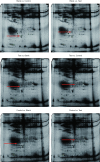Study on specific proteins involved in articular cartilage regeneration activity induced by decalcified bone transplantation
- PMID: 33569462
- PMCID: PMC7867953
- DOI: 10.21037/atm-20-8195
Study on specific proteins involved in articular cartilage regeneration activity induced by decalcified bone transplantation
Abstract
Background: Through a comprehensive analysis of the joint synovial fluid produced in the process of rabbit articular cartilage regeneration, the role and characteristics of knee synovial fluid in the process of decalcified bone transplantation-induced articular cartilage regeneration were explored.
Methods: Twenty New Zealand white rabbits (approximately 2.5 kg in weight) were selected, and bilateral distal femoral bones from two randomly selected rabbits were extracted. After decalcification, the bones were cut into 2 mm × 4 cm long decalcified bone strips. Meanwhile, the other 18 rabbits were randomly divided into three groups: the test group (8 rabbits), the positive control group (6 rabbits), and the blank group (4 rabbits). In the test group, the decalcified bone joint was transplanted into the rabbits at the articular cartilage defect; in the positive control group, the articular cartilage defect of the rabbits were treated and put aside; in the blank group, no rabbits were treated. On the day of transplantation, and on the 4th, 8th, 12th, and 16th weeks after transplantation, the joint synovial fluid of each group was taken for two-dimensional polyacrylamide gel electrophoresis (2D-PAGE), matrix-assisted laser desorption/ionization-time-of-flight mass spectrometry (MALDI-TOF-MS) analysis, and related database verification and identification, and compared with the positive control group and the blank group.
Results: Using 2D-PAGE to separate various proteins in the synovial fluid of the rabbit knee joints, it was found that there were differential protein spots in the test group compared with the blank group and the positive control group. After conducting a comparative search and query in the UniProt database, through comprehensive analysis, it was finally found that three proteins with molecular weights of 23,429.4, 57,431.4, and 26,071.1 that may be related to the regeneration of articular cartilage appeared in the test group.
Conclusions: In the process of inducing the regeneration of articular cartilage using decalcified bone transplantation, knee joint synovial fluid produced specific proteins, which may play an important role in the regeneration of articular cartilage. These findings may offer novel ideas in laying a foundation for the in-depth study of articular cartilage regeneration.
Keywords: Decalcified bone; articular cartilage regeneration; mass spectrometry analysis; specific protein; two-dimensional gel electrophoresis.
2021 Annals of Translational Medicine. All rights reserved.
Conflict of interest statement
Conflicts of Interest: All authors have completed the ICMJE uniform disclosure form (available at http://dx.doi.org/10.21037/atm-20-8195). The authors have no conflicts of interest to declare.
Figures



Similar articles
-
Coculture of allogenic DBM and BMSCs in the knee joint cavity of rabbits for cartilage tissue engineering.Biosci Rep. 2017 Nov 9;37(6):BSR20170804. doi: 10.1042/BSR20170804. Print 2017 Nov 22. Biosci Rep. 2017. PMID: 28931727 Free PMC article.
-
One-step repair for cartilage defects in a rabbit model: a technique combining the perforated decalcified cortical-cancellous bone matrix scaffold with microfracture.Am J Sports Med. 2014 Mar;42(3):583-91. doi: 10.1177/0363546513518415. Epub 2014 Feb 4. Am J Sports Med. 2014. PMID: 24496505
-
Study of a novel three-dimensional scaffold to repair bone defect in rabbit.J Biomed Mater Res A. 2014 May;102(5):1294-304. doi: 10.1002/jbm.a.34788. Epub 2013 Jun 7. J Biomed Mater Res A. 2014. PMID: 23650100
-
Hyaluronan thiomer gel/matrix mediated healing of articular cartilage defects in New Zealand White rabbits-a pilot study.J Exp Orthop. 2017 Dec;4(1):14. doi: 10.1186/s40634-017-0089-1. Epub 2017 May 3. J Exp Orthop. 2017. PMID: 28470629 Free PMC article.
-
[Articular cartilage regenerative therapy with synovial mesenchymal stem cells in a pig model].Clin Calcium. 2013 Dec;23(12):1741-9. Clin Calcium. 2013. PMID: 24292528 Review. Japanese.
Cited by
-
SCP2 mediates the transport of lipid hydroperoxides to mitochondria in chondrocyte ferroptosis.Cell Death Discov. 2023 Jul 8;9(1):234. doi: 10.1038/s41420-023-01522-x. Cell Death Discov. 2023. PMID: 37422468 Free PMC article.
References
-
- Lijun W, Xinming G. The articular cartilage injury prevention and control. People's Military Medical Press; 2004.
LinkOut - more resources
Full Text Sources
Other Literature Sources
